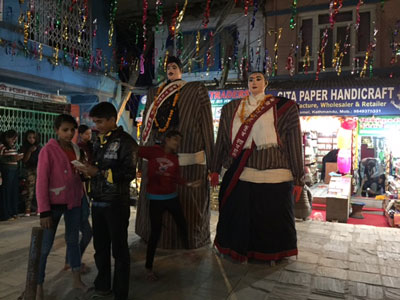Festival Calender
It is said about Nepal that every other structure is a holy shrine and every other day a festival. Well, if the number of annual festivals, both religious and national, is any indication, the saying couldn’t be more true. Festivals are an essential part of Nepalese life that garner tremendous local participation. Festivals also offer visitors a valuable opportunity not only for having fun but gaining insight into various aspects of Nepalese culture.
The religious festivals follow the lunar calendar, while national festivals have fixed dates. Wherever of whenever you arrive in Nepal, you can be pretty sure of being at the right time for one or more special events. Some of the major and interesting festivals are presented below.
Navavarsha (April):
The Nepalese New Year’s Day usually falls in the second week of April .i.e the first day of Baisakh . The day is observed as a national holiday. The people celebrate it with a great pomp and show. On this occasion, Bisket Jatra is held in the city of Bhaktapur.
Baisakh Poornima (April):
As Nepal is the birthplace of Lord Buddha, the light of Asia triple anniversary of the Buddha’s birth, enlightenment and death is observed with many colorful ceremonies on this day. People celebrate the occasion with great veneration paying homage to Buddha at places like Swayambhunath, Bouddhnath and Lumbini.
Red Machchheendreanath Rath Jatra (May-June
This Festival is the biggest socio-cultural event of patan. The wheeled chariot of a deity known as bungdyo or Red Machchheendreanath is made at Pulchowk and dragged through the city of Patan in several stages till it reaches the appointed destination (Lagankhel).The grand finale of the festival is called the ‘Bhoto Dekhune’ or the “Showing of a Vest”. A similar kind of chariot festival to Machchhendranth(white) is also held in Kathmandu city in the month of March-April.
Gaijatra (Cow festival):
It is a carnival that lasts eight days. Dancing, singing, comedy and anything that causes mirth and laughter are its highlights.
Karishnastmai: (July-August):
It marks the birthday of Lord Krishna. On this day, impressive ceremonies are conducted at the krishna Temple in patan and at Changu narayan.
Indrajata: (August-September):
The festival of indra, The god of rain, is observed with great enthusiasm in Kathmandu Valley. The festival lasts for eight days. The chariot of Kumari, the living Goddess, is taken out in procession through the main streets of Kathmandu. The festival is specially noted for the echoes of drums and dancing feet of the masked dancers almost every evening.
Dashain or Durga Puja (September - October):
The Dashain festival is the most important festival of the Nepalese. The entire country is in enthusiastic holiday mood at the time of the festival.
Tihar (Deepawali)(October-November):
Known as the Festival of Lights. Tihar is celebrated for five days. Houses are illuminated at night and special sweets of different varieties are prepared.
Vibha Panchami (november-December):
This is a famous festival of Janakpur in the eastern Terai. The occasion commemorates the marriage of Sita to Ram, one of the most venerated Hindu divinities. It attracts thousands of pilgrims from Indai to Janaki temple in Janakpur.
Lhosar:
This festival is most impressively observed in the month, of February by the Sherpas. They organized folk songs and dances on this occasion. These dances can be seen in Khumbu, Helabu and other northern region of Nepal and also at Bouddhnath in Kathmandu.
Maha Shivaratri (February):
Shivratri or the night of Lord Shiva is observed in February-March. It is celebrated in honour of lord Shiva. A Great religious fair takes place in the Pashupatinath Temple and thousand of people from all over Nepal and India flock the temple to worship Lord Shiva.
Ghodejatra (March-April):
Known as the festival of horses. It is one of the most exciting festivals of Kathmandu. Horse races and other sports take place and deities are carried shoulder-high on palanquin (kbat) to the accompaniment of traditional music.
Teej (August-September):
Teej is a hindu festival celebrated by women. Dancing, Folk song and the red colour of women’s wedding saris dominate the days of teej. Women observe a fast and flick to Shiva temples where married ones pray for a happy conjugal life and unmarried ones of a good husband.
If you would like some more information about festivals, or anything else, please contact Dave at Design Himalaya



